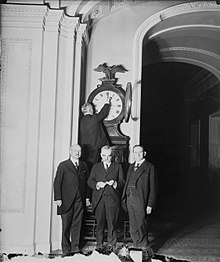Time for North Americans to spring ahead one hour
Sunday, April 3, 2005

The time has come for North Americans to enjoy the extra length of the Northern Hemisphere’s spring and summer day, by observing Daylight Saving Time (DST).
In most areas of the United States, Canada, and Mexico, DST observers should turn their clocks ahead one hour at 2 a.m. Sunday morning.
In Canada, the change takes effect in Newfoundland and New Brunswick at 12:01 a.m., and 2 a.m. in most of the rest of the country.
Arizona, Hawaii, the part of Indiana in the Eastern time zone, Puerto Rico, the Virgin Islands and American Samoa do not change their clocks. Certain areas in Canada also do not observe DST, such as Saskatchewan province. Mexico only started observing DST in 1996, after the North American Free Trade Agreement, to coordinate their times with neighbouring states.
North America isn't the only region observing DST. Many European countries began last week and several countries south of the equator returned to standard time in March as they enter autumn. Other countries continue to discuss whether or not a switch to the system is a good idea. In Israel, a Knesset committee recently decided to begin observing daylight savings on the last Thursday before April 1.
In North America, daylight savings time ends the last Sunday in October.
Safety advocates say this is a good time to change batteries in your smoke detector as well.
Related news
edit- "US House committee approves daylight saving time amendment" — Wikinews, April 7, 2005
See also
editSources
edit- "Daylight Savings Time returns this weekend" — Yahoo news, April 3, 2005
- "Spring ahead: get ready for Daylight Saving" — CTV, April 3, 2005
- AP. "Daylight-Saving Time Returns This Weekend" — Guardian Unlimited, April 2, 2005
- Daniel Kennemer. "How much is Daylight-Savings Time worth?" — Jerusalem Post, March 31, 2005